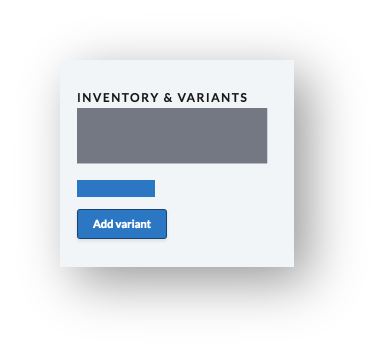Variants are useful when organizing your inventory when you have products that vary in a small ways. For example, a t-shirt product that varies by size and color may have 5 different sizes and 3 different colors. This means this specific t-shirt product will have 15 unique variants. Click here for a further definition of variant.
Variants are counted in the product limit of your subscription. For example, if you're subscribed to the Essential package, with 250 products, and you assign 10 variants to a product, you have 240 products remaining.
Creating a variant
- Open your eCom Back Office and click Products.
- Select any product by clicking on the product title.
- Scroll down to INVENTORY & VARIANTS and click the Add variant button.
- In the section called TITLE, enter the name of the variant.
- Optionally, enter more details about the variant and click Save. For more information on the details you can edit, visit Configuring a variant.
Missing the Add variant button
In the instructions to add a variant in step 3, if you don't see the Add variant button, your eCom store may be connected to the inventory of a physical store's location. In this case, you need to create variants in the inventory software you use at that location. If this software is made by Lightspeed, it's called Lightspeed Retail or OnSite. In both, variants are created when you create a matrix and you publish them to eCom. For more information:
- For Retail, visit Creating matrices and Publishing items in eCom.
- For OnSite, visit Creating a color-size matrix and Managing product visibility in eCom.
Faster method of adding variants
- Visit Creating product sets to learn how to add a set of variants to a specific product.
- Visit Importing new products and Editing products via import to learn how to import products.
More information
To learn how to:
- Manage variants from the product page, click here.
- Configure a variant, click here.
- Manage the default settings for variants, click here.
Defining Variant
In Lightspeed eCom, variants are grouped items that differ by one, two or more specific ways.
Products that differ in 1 way
You can create one product with variants that differ in only 1 way:
For example: You have a product called John's Tee and you have the sizes: small, medium and large. Once you add it to Lightspeed eCom, when a customer views the product John's Tee, he will see 1 dropdown with the following options:
- Size:
- Small
- Medium
- Large
- In total, you have 3 variants (1 x 3) in your product.
Products that differ 2 in ways
You can create one product with variants that differ in 2 ways:
For example: You have a product called Monster Bike and you have the colors: red, black and blue and you have the sizes: child and adult. Once you add it to Lightspeed eCom, when a customer views the product Monster Bike, he will see 2 dropdowns with the following options:
- Colour:
- Red
- Black
- Blue.
- Size:
- Child
- Adult
- In total, you have 6 variants (3 x 2) in your product.
Products that differ in more ways
- eCom - If you are using Lightspeed eCom, you can create products that differ in many ways, limited to up to 100 variants per product set. For more information, visit Creating product sets.
- Retail with eCom Omnichannel - If you use Lightspeed Retail with eCom, you can create products that differ in up to 3 ways by creating a product matrix in your Retail account. For more information, visit Creating matrices.
- OnSite with eCom Omnichannel - If you use Lightspeed OnSite with eCom, you can create products that differ in up to 2 ways by creating a matrix. For more information, visit Understanding matrices in OnSite.